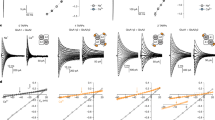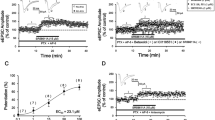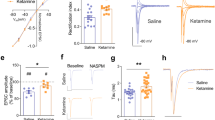Abstract
Benzodiazepine withdrawal anxiety is associated with potentiation of α-amino-3-hydroxy-5-methyl-4-isoxazolepropionate receptor (AMPAR) currents in hippocampal CA1 pyramidal neurons attributable to increased synaptic incorporation of GluA1-containing AMPARs. The contribution of calcium/calmodulin-dependent protein kinase II (CaMKII) to enhanced glutamatergic synaptic strength during withdrawal from 1-week oral flurazepam (FZP) administration was further examined in hippocampal slices. As earlier reported, AMPAR-mediated miniature excitatory postsynaptic current (mEPSC) amplitude increased in CA1 neurons from 1- and 2-day FZP-withdrawn rats, along with increased single-channel conductance in neurons from 2-day rats, estimated by non-stationary noise analysis. Input–output curve slope was increased without a change in paired-pulse facilitation, suggesting increased AMPAR postsynaptic efficacy rather than altered glutamate release. The increased mEPSC amplitude and AMPAR conductance were related to CaMKII activity, as intracellular inclusion of CaMKIINtide or autocamtide-2-related inhibitory peptide, but not scrambled peptide, prevented both AMPAR amplitude and conductance changes. mEPSC inhibition by 1-naphthyl acetyl spermine and the negative shift in rectification index at both withdrawal time points were consistent with functional incorporation of GluA2-lacking AMPARs. GluA1 but not GluA2 or GluA3 levels were increased in immunoblots of postsynaptic density (PSD)-enriched subcellular fractions of CA1 minislices from 1-day FZP-withdrawn rats, when mEPSC amplitude, but not conductance, was increased. Both GluA1 expression levels and CaMKIIα-mediated GluA1 Ser831 phosphorylation were increased in PSD-subfractions from 2-day FZP-withdrawn rats. As phospho-Thr286CaMKIIα was unchanged, CaMKIIα may be activated through an alternative signaling pathway. Synaptic insertion and subsequent CaMKIIα-mediated Ser831 phosphorylation of GluA1 homomers contribute to benzodiazepine withdrawal-induced AMPAR potentiation and may represent an important hippocampal pathway mediating both drug-induced and activity-dependent plasticity.
Similar content being viewed by others
Log in or create a free account to read this content
Gain free access to this article, as well as selected content from this journal and more on nature.com
or
References
Adesnik H, Nicoll RA (2007). Conservation of glutamate receptor 2-containing AMPA receptors during long-term potentiation. J Neurosci 27: 4598–4602.
Anderson SM, Famous KR, Sadri-Vakili G, Kumaresan V, Schmidt HD, Bass CE et al (2008). CaMKII: a biochemical bridge linking accumbens dopamine and glutamate systems in cocaine seeking. Nat Neurosci 11: 344–353.
Allison C, Pratt JA (2003). Neuroadaptive processes in GABAergic and glutamatergic systems in benzodiazepine dependence. Pharmacol Ther 98: 171–195.
Barria A, Derkach V, Soderling T (1997a). Identification of the Ca2+/calmodulin-dependent protein kinase II regulatory phosphorylation site in the alpha-amino-3-hydroxyl-5-methyl-4-isoxazole-propionate-type glutamate receptor. J Biol Chem 272: 32727–32730.
Barria A, Muller D, Derkach V, Griffith LC, Soderling TR (1997b). Regulatory phosphorylation of AMPA-type glutamate receptors by CaM-KII during long-term potentiation. Science 276: 2042–2045.
Bateson AN (2002). Basic pharmacologic mechanisms involved in benzodiazepine tolerance and withdrawal. Curr Pharm Des 8: 5–21.
Bayer KU, De Koninck P, Leonard AS, Hell JW, Schulman H (2001). Interaction with the NMDA receptor locks CaMKII in an active conformation. Nature 411: 801–805.
Bayer KU, LeBel E, McDonald GL, O′Leary H, Schulman H, De Koninck P (2006). Transition from reversible to persistent binding of CaMKII to postsynaptic sites and NR2B. J Neurosci 26: 1164–1174.
Benke TA, Luthi A, Isaac JT, Collingridge GL (1998). Modulation of AMPA receptor unitary conductance by synaptic activity. Nature 393: 793–797.
Boudreau AC, Ferrario CR, Glucksman MJ, Wolf ME (2009). Signaling pathway adaptations and novel protein kinase A substrates related to behavioral sensitization to cocaine. J Neurochem 110: 363–377.
Boudreau AC, Wolf ME (2005). Behavioral sensitization to cocaine is associated with increased AMPA receptor surface expression in the nucleus accumbens. J Neurosci 25: 9144–9151.
Collingridge GL, Isaac JT, Wang YT (2004). Receptor trafficking and synaptic plasticity. Nat Rev Neurosci 5: 952–962.
Collingridge GL, Olsen RW, Peters J, Spedding M (2009). A nomenclature for ligand-gated ion channels. Neuropharmacology 56: 2–5.
Das P, Lilly SM, Zerda R, Gunning III WT, Alvarez FJ, Tietz EI (2008). Increased AMPA receptor GluR1 subunit incorporation in rat hippocampal CA1 synapses during benzodiazepine withdrawal. J Comp Neurol 511: 832–846.
Das P, Zerda R, Alvarez FJ, Tietz EI (2010). Immunogold electron microscopic evidence of differential regulation of GluN1, GluN2A and GluN2B, NMDA-type glutamate receptor subunits in rat hippocampal CA1 synapses during benzodiazepine withdrawal. J Comp Neurol, (in press).
Derkach V, Barria A, Soderling TR (1999). Ca2+/calmodulin-kinase II enhances channel conductance of alpha-amino-3-hydroxy-5-methyl-4-isoxazolepropionate type glutamate receptors. Proc Natl Acad Sci USA 96: 3269–3274.
Derkach VA, Oh MC, Guire ES, Soderling TR (2007). Regulatory mechanisms of AMPA receptors in synaptic plasticity. Nat Rev Neurosci 8: 101–113.
Dunworth SJ, Stephens DN (1998). Sensitisation to repeated withdrawal, in mice treated chronically with diazepam, is blocked by an NMDA receptor antagonist. Psychopharmacology (Berl) 136: 308–310.
Edwards S, Graham DL, Whisler KN, Self DW (2009). Phosphorylation of GluR1, ERK, and CREB during spontaneous withdrawal from chronic heroin self-administration. Synapse 63: 224–235.
Esteban JA, Shi SH, Wilson C, Nuriya M, Huganir RL, Malinow R (2003). PKA phosphorylation of AMPA receptor subunits controls synaptic trafficking underlying plasticity. Nat Neurosci 6: 136–143.
Fitzgerald LW, Ortiz J, Hamedani AG, Nestler EJ (1996). Drugs of abuse and stress increase the expression of GluR1 and NMDAR1 glutamate receptor subunits in the rat ventral tegmental area: common adaptations among cross-sensitizing agents. J Neurosci 16: 274–282.
Ford KA, Wolf ME, Hu XT (2009). Plasticity of L-type Ca2+ channels after cocaine withdrawal. Synapse 63: 690–697.
Gao L, Blair LA, Marshall J (2006). CaMKII-independent effects of KN93 and its inactive analog KN92: reversible inhibition of L-type calcium channels. Biochem Biophys Res Commun 345: 1606–1610.
Gebhardt C, Cull-Candy SG (2006). Influence of agonist concentration on AMPA and kainate channels in CA1 pyramidal cells in rat hippocampal slices. J Physiol 573: 371–394.
Ghasemzadeh MB, Mueller C, Vasudevan P (2009). Behavioral sensitization to cocaine is associated with increased glutamate receptor trafficking to the postsynaptic density after extended withdrawal period. Neuroscience 159: 414–426.
Glass MJ, Kruzich PJ, Colago EE, Kreek MJ, Pickel VM (2005). Increased AMPA GluR1 receptor subunit labeling on the plasma membrane of dendrites in the basolateral amygdala of rats self-administering morphine. Synapse 58: 1–12.
Glass MJ, Lane DA, Colago EE, Chan J, Schlussman SD, Zhou Y et al (2008). Chronic administration of morphine is associated with a decrease in surface AMPA GluR1 receptor subunit in dopamine D1 receptor expressing neurons in the shell and non-D1 receptor expressing neurons in the core of the rat nucleus accumbens. Exp Neurol 210: 750–761.
Griffiths RR, Johnson MW (2005). Relative abuse liability of hypnotic drugs: a conceptual framework and algorithm for differentiating among compounds. J Clin Psychiatry 66 (Suppl 9): 31–41.
Guire ES, Oh MC, Soderling TR, Derkach VA (2008). Recruitment of calcium-permeable AMPA receptors during synaptic potentiation is regulated by CaM-kinase I. J Neurosci 28: 6000–6008.
Hayashi Y, Shi SH, Esteban JA, Piccini A, Poncer JC, Malinow R (2000). Driving AMPA receptors into synapses by LTP and CaMKII: requirement for GluR1 and PDZ domain interaction. Science 287: 2262–2267.
He K, Song L, Cummings LW, Goldman J, Huganir RL, Lee HK (2009). Stabilization of Ca2+-permeable AMPA receptor at perisynaptic sites by GluR1-S845 phosphorylation. Proc Natl Acad Sci USA 106: 20033–20038.
Hollmann M, Hartley M, Heinemann S (1991). Ca2+ permeability of KA-AMPA—gated glutamate receptor channels depends on subunit composition. Science 252: 851–853.
Ishida A, Kameshita I, Okuno S, Kitani T, Fujisawa H (1995). A novel highly specific and potent inhibitor of calmodulin-dependent protein kinase II. Biochem Biophys Res Commun 212: 806–812.
Izzo E, Auta J, Impagnatiello F, Pesold C, Guidotti A, Costa E (2001). Glutamic acid decarboxylase and glutamate receptor changes during tolerance and dependence to benzodiazepines. Proc Natl Acad Sci USA 98: 3483–3488.
Katsura M, Shibasaki M, Kurokawa K, Tsujimura A, Ohkuma S (2007). Up-regulation of L-type high voltage-gated calcium channel subunits by sustained exposure to 1,4- and 1,5-benzodiazepines in cerebrocortical neurons. J Neurochem 103: 2518–2528.
Kauer JA, Malenka RC (2007). Synaptic plasticity and addiction. Nat Rev Neurosci 8: 844–858.
Koff JM, Pritchard GA, Greenblatt DJ, Miller LG (1997). The NMDA receptor competitive antagonist CPP modulates benzodiazepine tolerance and discontinuation. Pharmacology 55: 217–227.
Lee HK, Takamiya K, He K, Song L, Huganir RL (2010). Specific roles of AMPA receptor subunit GluR1 (GluA1) phosphorylation sites in regulating synaptic plasticity in the CA1 region of hippocampus. J Neurophysiol 103: 479–489.
Lerma J, Morales M, Ibarz JM, Somohano F (1994). Rectification properties and Ca2+ permeability of glutamate receptor channels in hippocampal cells. Eur J Neurosci 6: 1080–1088.
Lisman J, Schulman H, Cline H (2002). The molecular basis of CaMKII function in synaptic and behavioural memory. Nat Rev Neurosci 3: 175–190.
Lledo PM, Hjelmstad GO, Mukherji S, Soderling TR, Malenka RC, Nicoll RA (1995). Calcium/calmodulin-dependent kinase II and long-term potentiation enhance synaptic transmission by the same mechanism. Proc Natl Acad Sci USA 92: 11175–11179.
Llinas R, McGuinness TL, Leonard CS, Sugimori M, Greengard P (1985). Intraterminal injection of synapsin I or calcium/calmodulin-dependent protein kinase II alters neurotransmitter release at the squid giant synapse. Proc Natl Acad Sci USA 82: 3035–3039.
Loweth JA, Singer BF, Baker LK, Wilke G, Inamine H, Bubula N et al (2010). Transient overxpression of alpha-Ca2+/calmodulin-dependent protein kinase II in the nucleus accumbens shell enhances behavioral responding to amphetamine. J Neurosci 30: 939–949.
Lu W, Shi Y, Jackson AC, Bjorgan K, During MJ, Sprengel R et al (2009). Subunit composition of synaptic AMPA receptors revealed by a single-cell genetic approach. Neuron 62: 254–268.
Luthi A, Wikstrom MA, Palmer MJ, Matthews P, Benke TA, Isaac JT et al (2004). Bi-directional modulation of AMPA receptor unitary conductance by synaptic activity. BMC Neurosci 5: 44.
Mammen AL, Kameyama K, Roche KW, Huganir RL (1997). Phosphorylation of the alpha-amino-3-hydroxy-5-methylisoxazole4-propionic acid receptor GluR1 subunit by calcium/calmodulin-dependent kinase II. J Biol Chem 272: 32528–32533.
Margrie TW, Rostas JA, Sah P (1998). Presynaptic long-term depression at a central glutamatergic synapse: a role for CaMKII. Nat Neurosci 1: 378–383.
McKernan MG, Shinnick-Gallagher P (1997). Fear conditioning induces a lasting potentiation of synaptic currents in vitro. Nature 390: 607–611.
Moga DE, Janssen WG, Vissavajjhala P, Czelusniak SM, Moran TM, Hof PR et al (2003). Glutamate receptor subunit 3 (GluR3) immunoreactivity delineates a subpopulation of parvalbumin-containing interneurons in the rat hippocampus. J Comp Neurol 462: 15–28.
Nasif FJ, Hu XT, White FJ (2005). Repeated cocaine administration increases voltage-sensitive calcium currents in response to membrane depolarization in medial prefrontal cortex pyramidal neurons. J Neurosci 25: 3674–3679.
Nicoll RA (2003). Expression mechanisms underlying long-term potentiation: a postsynaptic view. Philos Trans R Soc Lond B Biol Sci 358: 721–726.
Oh MC, Derkach VA (2005). Dominant role of the GluR2 subunit in regulation of AMPA receptors by CaMKII. Nat Neurosci 8: 853–854.
Ortiz J, Fitzgerald LW, Charlton M, Lane S (1995). Biochemical actions of chronic ethanol exposure in the mesolimbic dopamine system. Synapse 21: 289–298.
Pellegrini-Giampietro DE (2003). An activity-dependent spermine-mediated mechanism that modulates glutamate transmission. Trends Neurosci 26: 9–11.
Plant K, Pelkey KA, Bortolotto ZA, Morita D, Terashima A, McBain CJ et al (2006). Transient incorporation of native GluR2-lacking AMPA receptors during hippocampal long-term potentiation. Nat Neurosci 9: 602–604.
Poncer JC, Esteban JA, Malinow R (2002). Multiple mechanisms for the potentiation of AMPA receptor-mediated transmission by alpha-Ca2+/calmodulin-dependent protein kinase II. J Neurosci 22: 4406–4411.
Rodrigues SM, Schafe GE, LeDoux JE (2004). Molecular mechanisms underlying emotional learning and memory in the lateral amygdala. Neuron 44: 75–91.
Sanhueza M, McIntyre CC, Lisman JE (2007). Reversal of synaptic memory by Ca2+/calmodulin-dependent protein kinase II inhibitor. J Neurosci 27: 5190–5199.
Sans N, Vissel B, Petralia RS, Wang YX, Chang K, Royle GA et al (2003). Aberrant formation of glutamate receptor complexes in hippocampal neurons of mice lacking the GluR2 AMPA receptor subunit. J Neurosci 23: 9367–9373.
Seeburg PH (1996). The role of RNA editing in controlling glutamate receptor channel properties. J Neurochem 66: 1–5.
Shen G, Tietz EI (2008). Regulation of synaptic NR2B subunit-containing NMDA receptors: one component of glutamatergic plasticity in benzodiazepine withdrawal-anxiety. Soc Neurosci Abstr Program # 662, Neuroscience Meeting Planner. Society for Neuroscience: Washington DC, 2008. Online.
Shen G, Van Sickle BJ, Tietz EI (2009). Positive allosteric activation of GABAA receptors bi-directionally modulates hippocampal glutamate plasticity and behavior. Biochem Soc Trans 37: 1394–1398.
Shen H, Gong QH, Aoki C, Yuan M, Ruderman Y, Dattilo M et al (2007). Reversal of neurosteroid effects at alpha4beta2delta GABAA receptors triggers anxiety at puberty. Nat Neurosci 10: 469–477.
Shen K, Teruel MN, Subramanian K, Meyer T (1998). CaMKIIbeta functions as an F-actin targeting module that localizes CaMKIIalpha/beta heterooligomers to dendritic spines. Neuron 21: 593–606.
Shi SH, Hayashi Y, Petralia RS, Zaman SH, Wenthold RJ, Svoboda K et al (1999). Rapid spine delivery and redistribution of AMPA receptors after synaptic NMDA receptor activation. Science 284: 1811–1816.
Song J, Shen G, Greenfield Jr LJ, Tietz EI (2007). Benzodiazepine withdrawal-induced glutamatergic plasticity involves up-regulation of GluR1-containing alpha-amino-3-hydroxy-5-methylisoxazole-4-propionic acid receptors in Hippocampal CA1 neurons. J Pharmacol Exp Ther 322: 569–581.
Song J, Tietz EI (2004). AMPA receptor plasticity in benzodiazepine-withdrawn rats is associated with only a transient increase in GluR1 subunit Ser845 phosphorylation in hippocampal CA1 neurons. Soc Neurosci Abstr Program No. 511.5, Neuroscience Meeting Planner. Society for Neuroscience: San Diego, CA, 2004. Online.
Spruston N, Jonas P, Sakmann B (1995). Dendritic glutamate receptor channels in rat hippocampal CA3 and CAl pyramidal neurons. J Physiol 482: 325–352.
Sutton MA, Schmidt EF, Choi KH, Schad CA, Whisler K, Simmons D et al (2003). Extinction-induced upregulation in AMPA receptors reduces cocaine-seeking behaviour. Nature 421: 70–75.
Swanson GT, Kamboj SK, Cull-Candy SG (1997). Single-channel properties of recombinant AMPA receptors depend on RNA editing, splice variation, and subunit composition. J Neurosci 17: 58–69.
Van Sickle BJ, Cox AS, Schak K, Greenfield Jr LJ, Tietz EI (2002). Chronic benzodiazepine administration alters hippocampal CA1 neuron excitability: NMDA receptor function and expression(1). Neuropharmacology 43: 595–606.
Van Sickle BJ, Tietz EI (2002). Selective enhancement of AMPA receptor-mediated function in hippocampal CA1 neurons from chronic benzodiazepine-treated rats. Neuropharmacology 43: 11–27.
Van Sickle BJ, Xiang K, Tietz EI (2004). Transient plasticity of hippocampal CA1 neuron glutamate receptors contributes to benzodiazepine withdrawal-anxiety. Neuropsychopharmacology 29: 1994–2006.
Wafford KA (2005). GABA-A receptor subtypes: any clues to the mechanism of benzodiazepine dependence? Curr Opin Pharmacol 5: 47–52.
Wang JH, Kelly PT (1995). Postsynaptic injection of Ca2+/CaM induces synaptic potentiation requiring CaMKII and PKC activity. Neuron 15: 443–452.
Washburn MS, Dingledine R (1996). Block of alpha-amino-3-hydroxy-5-methyl-4-isoxazolepropionic acid (AMPA) receptors by polyamines and polyamine toxins. J Pharmacol Exp Ther 278: 669–678.
Wenthold RJ, Petralia RS, Blahos II J, Niedzielski AS (1996). Evidence for multiple AMPA receptor complexes in hippocampal CA1/CA2 neurons. J Neurosci 16: 1982–1989.
Wolf ME, Sun X, Mangiavacchi S, Chao SZ (2004). Psychomotor stimulants and neuronal plasticity. Neuropharmacology 47: 61–79.
Xiang K, Earl DE, Davis K, Giovannucci DR, Greenfield Jr LJ, Tietz EI (2008). Chronic benzodiazepine administration potentiates high voltage-activated calcium currents in hippocampal CA1 neurons. J Pharmacol Exp Ther 327: 872–883.
Xiang K, Tietz EI (2007). Benzodiazepine-induced hippocampal CA1 neuron alpha-amino- hydroxy-5-methylisoxasole-4-propionic acid (AMPA) receptor plasticity linked to severity of withdrawal anxiety: differential role of voltage-gated calcium channels and N-methyl-D-aspartic acid receptors. Behav Pharmacol 18: 447–460.
Zeng X, Tietz EI (1999). Benzodiazepine tolerance at GABAergic synapses on hippocampal CA1 pyramidal cells. Synapse 31: 263–277.
Zhu JJ, Esteban JA, Hayashi Y, Malinow R (2000). Postnatal synaptic potentiation: delivery of GluA4-containing AMPA receptors by spontaneous activity. Nat Neurosci 3: 1098–1106.
Acknowledgements
We thank Krista Pettee, Brian Behrle, Margarete Otting, and Eugene Orlowski for expert technical assistance. We also acknowledge LJ Greenfield, Jr MD PhD for critically reading the final manuscript. This work was supported by Department of Health and Human Services grant R01-DA18342 from the National Institute on Drug Abuse (NIDA) to E.I.T.; an individual predoctoral NRSA grant F30-DA06041 from NIDA to BJV; and predoctoral fellowships from the University of Toledo College of Medicine Biomedical Sciences Graduate Program (to GS and BJV). The National Institute of Drug Abuse Drug Supply Program supplied flurazepam.
Author information
Authors and Affiliations
Corresponding author
Ethics declarations
Competing interests
The authors declare that, except for income received from our primary employers, no financial support or compensation has been received from any individual or corporate entity over the past 3 years for research or professional service and there are no personal financial holdings that could be perceived as constituting a potential conflict of interest.
Rights and permissions
About this article
Cite this article
Shen, G., Van Sickle, B. & Tietz, E. Calcium/Calmodulin-Dependent Protein Kinase II Mediates Hippocampal Glutamatergic Plasticity During Benzodiazepine Withdrawal. Neuropsychopharmacol 35, 1897–1909 (2010). https://doi.org/10.1038/npp.2010.61
Received:
Revised:
Accepted:
Published:
Issue date:
DOI: https://doi.org/10.1038/npp.2010.61
Keywords
This article is cited by
-
Electrophysiological properties of hippocampal–cortical neural networks, role in the processes of learning and memory in rats
Journal of Neural Transmission (2014)
-
Increased Expression of Calcium/Calmodulin-Dependent Protein Kinase Type II Subunit Delta after Rat Traumatic Brain Injury
Journal of Molecular Neuroscience (2012)



